Tragedy in the Skies: Air India Flight AI171 Crashes Shortly After Takeoff from Ahmedabad.

June 12, 2025
In a devastating aviation disaster, Air India Flight AI171—a Boeing 787-8 Dreamliner bound for London Gatwick—crashed shortly after takeoff from Ahmedabad’s Sardar Vallabhbhai Patel International Airport on Thursday afternoon, killing many of the 242 people on board. The incident has shocked the nation and drawn international attention as officials scramble to understand what led to one of the most severe air accidents in recent Indian aviation history.
According to data from Air India and the Directorate General of Civil Aviation (DGCA), Flight AI171 departed from Ahmedabad at approximately 1:38 PM IST. Within five minutes of takeoff, the pilot issued a "Mayday" distress signal, citing engine irregularities and an inability to gain altitude. Moments later, the aircraft disappeared from radar screens and crashed into a densely populated area of Meghani Nagar, just outside the airport perimeter.
Eyewitnesses reported a deafening explosion and a rising plume of black smoke as the aircraft struck a residential building, believed to be part of a doctors’ hostel complex. Videos circulating on social media—and later confirmed by Reuters—show chaotic scenes of firefighters battling towering flames, while emergency services rushed injured residents and possible survivors to nearby hospitals.
Air India confirmed that 242 people were aboard the aircraft, including 230 passengers and 12 crew members. The passenger manifest included 169 Indian nationals, 53 British citizens, seven Portuguese, and one Canadian. The identities of the victims have not been publicly released, pending family notifications. Hospitals in Ahmedabad have been placed on high alert, and local authorities have set up helplines and support centers for grieving relatives.
The aircraft involved in the crash, a Boeing 787-8 registered as VT-ANB, was approximately 11 years old. According to aviation safety analysts cited by NPR and the Aviation Safety Network, this incident marks the first-ever fatal crash involving a Boeing 787 Dreamliner, a model widely used for long-haul international flights.
Air India’s internal maintenance logs reportedly show that the aircraft underwent routine inspection just weeks prior, although whether any mechanical fault contributed to the crash is now the subject of intense investigation.
India's Civil Aviation Minister and DGCA officials arrived in Ahmedabad by evening to oversee the investigation. A team from Boeing’s international safety division is also expected to join the probe. The aircraft’s flight data recorder (black box) and cockpit voice recorder have reportedly been located and are in the process of being recovered.
In an official statement, Prime Minister Narendra Modi expressed his deep condolences, stating, "This is a terrible day for Indian aviation. My thoughts are with the families of the victims. The nation mourns with them, and we will ensure a full and transparent investigation."
Rescue operations continued into the night as disaster response teams worked to recover bodies and extinguish residual fires. Several residential buildings were partially destroyed by the crash, though officials have yet to confirm how many people on the ground may have been killed or injured. Medical teams are providing trauma counseling to survivors and bystanders affected by the horrific scenes.
Local residents, many of whom witnessed the crash, described the horror of seeing a fully loaded passenger aircraft hurtling towards their neighborhood. One eyewitness told Reuters, "I heard a loud engine roar overhead, followed by a sharp explosion. When I came out, I saw fire everywhere—bodies, metal, debris. It was like a war zone."
The United Kingdom’s Foreign Office released a statement confirming that British citizens were among those on board and that they are coordinating with Indian authorities for assistance. The Canadian and Portuguese governments also expressed condolences and offered to send representatives to assist with identification and repatriation processes.
Aviation safety authorities around the world, including the U.S. Federal Aviation Administration (FAA) and the European Union Aviation Safety Agency (EASA), have offered technical assistance and are closely monitoring developments.
As India grapples with the shock and grief from this tragedy, questions are already being raised about flight safety, emergency preparedness, and infrastructure capacity at major airports. Lawmakers have called for a parliamentary review of aviation oversight procedures, and the DGCA has pledged to audit Air India's fleet and operations in the coming weeks.
In the meantime, Ahmedabad Airport remains closed to commercial flights, and an area spanning several kilometers around the crash site has been cordoned off as a disaster zone.
Today’s Air India crash is not just a tragic aviation accident—it is a somber reminder of the fragility of life and the need for unrelenting commitment to safety, accountability, and compassion. As families await answers and the nation mourns, the world watches with bated breath for clarity on what went wrong—and how such a catastrophe can be prevented in the future.
In a devastating aviation disaster, Air India Flight AI171—a Boeing 787-8 Dreamliner bound for London Gatwick—crashed shortly after takeoff from Ahmedabad’s Sardar Vallabhbhai Patel International Airport on Thursday afternoon, killing many of the 242 people on board. The incident has shocked the nation and drawn international attention as officials scramble to understand what led to one of the most severe air accidents in recent Indian aviation history.
According to data from Air India and the Directorate General of Civil Aviation (DGCA), Flight AI171 departed from Ahmedabad at approximately 1:38 PM IST. Within five minutes of takeoff, the pilot issued a "Mayday" distress signal, citing engine irregularities and an inability to gain altitude. Moments later, the aircraft disappeared from radar screens and crashed into a densely populated area of Meghani Nagar, just outside the airport perimeter.
Eyewitnesses reported a deafening explosion and a rising plume of black smoke as the aircraft struck a residential building, believed to be part of a doctors’ hostel complex. Videos circulating on social media—and later confirmed by Reuters—show chaotic scenes of firefighters battling towering flames, while emergency services rushed injured residents and possible survivors to nearby hospitals.
Air India confirmed that 242 people were aboard the aircraft, including 230 passengers and 12 crew members. The passenger manifest included 169 Indian nationals, 53 British citizens, seven Portuguese, and one Canadian. The identities of the victims have not been publicly released, pending family notifications. Hospitals in Ahmedabad have been placed on high alert, and local authorities have set up helplines and support centers for grieving relatives.
The aircraft involved in the crash, a Boeing 787-8 registered as VT-ANB, was approximately 11 years old. According to aviation safety analysts cited by NPR and the Aviation Safety Network, this incident marks the first-ever fatal crash involving a Boeing 787 Dreamliner, a model widely used for long-haul international flights.
Air India’s internal maintenance logs reportedly show that the aircraft underwent routine inspection just weeks prior, although whether any mechanical fault contributed to the crash is now the subject of intense investigation.
India's Civil Aviation Minister and DGCA officials arrived in Ahmedabad by evening to oversee the investigation. A team from Boeing’s international safety division is also expected to join the probe. The aircraft’s flight data recorder (black box) and cockpit voice recorder have reportedly been located and are in the process of being recovered.
In an official statement, Prime Minister Narendra Modi expressed his deep condolences, stating, "This is a terrible day for Indian aviation. My thoughts are with the families of the victims. The nation mourns with them, and we will ensure a full and transparent investigation."
Rescue operations continued into the night as disaster response teams worked to recover bodies and extinguish residual fires. Several residential buildings were partially destroyed by the crash, though officials have yet to confirm how many people on the ground may have been killed or injured. Medical teams are providing trauma counseling to survivors and bystanders affected by the horrific scenes.
Local residents, many of whom witnessed the crash, described the horror of seeing a fully loaded passenger aircraft hurtling towards their neighborhood. One eyewitness told Reuters, "I heard a loud engine roar overhead, followed by a sharp explosion. When I came out, I saw fire everywhere—bodies, metal, debris. It was like a war zone."
The United Kingdom’s Foreign Office released a statement confirming that British citizens were among those on board and that they are coordinating with Indian authorities for assistance. The Canadian and Portuguese governments also expressed condolences and offered to send representatives to assist with identification and repatriation processes.
Aviation safety authorities around the world, including the U.S. Federal Aviation Administration (FAA) and the European Union Aviation Safety Agency (EASA), have offered technical assistance and are closely monitoring developments.
As India grapples with the shock and grief from this tragedy, questions are already being raised about flight safety, emergency preparedness, and infrastructure capacity at major airports. Lawmakers have called for a parliamentary review of aviation oversight procedures, and the DGCA has pledged to audit Air India's fleet and operations in the coming weeks.
In the meantime, Ahmedabad Airport remains closed to commercial flights, and an area spanning several kilometers around the crash site has been cordoned off as a disaster zone.
Today’s Air India crash is not just a tragic aviation accident—it is a somber reminder of the fragility of life and the need for unrelenting commitment to safety, accountability, and compassion. As families await answers and the nation mourns, the world watches with bated breath for clarity on what went wrong—and how such a catastrophe can be prevented in the future.






